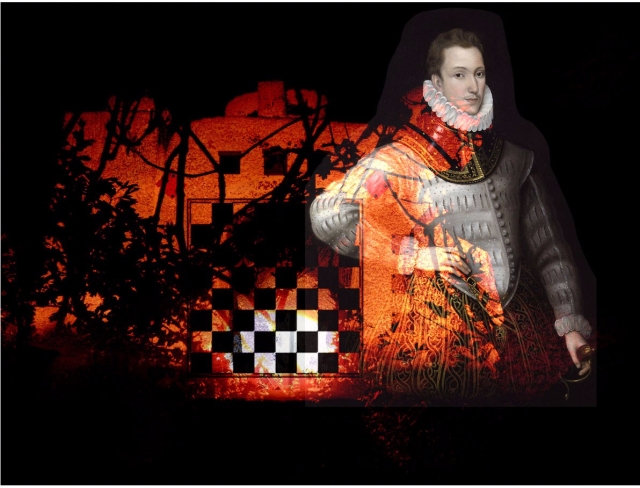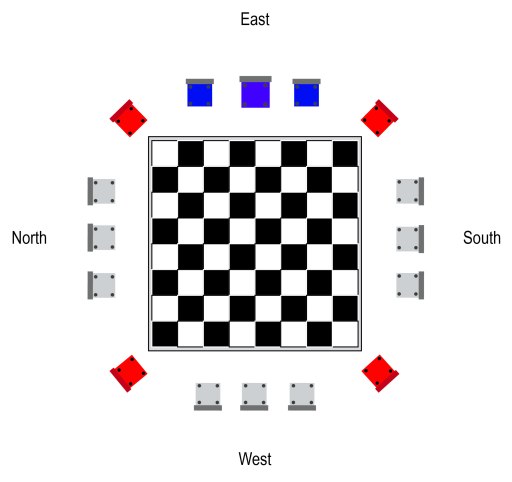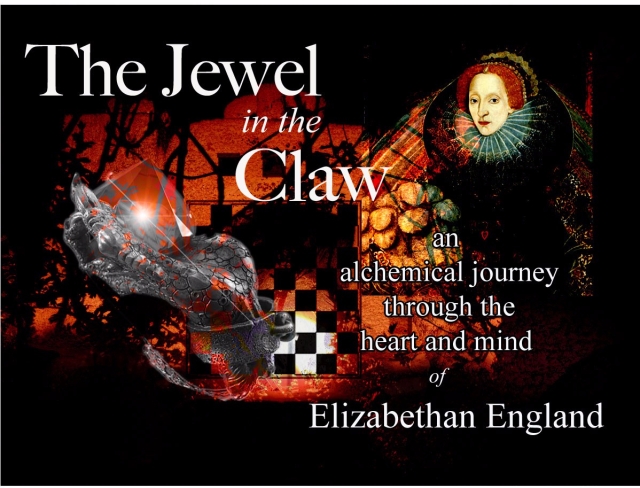
(Image: Sir Philip Sidney, Queen’s Champion. Original work – Author. Figure of Sir Philip Sidney from Wikipedia CC by Public Domain)
Philip Sidney was born, in 1554, into prosperity and with connections. He was the eldest son of Sir Henry Sidney and Lady Mary Dudley – making him a relative of the 1st Duke of Northumberland and the 1st Earl of Leicester, Robert Dudley.
He was educated at Shrewsbury School and Christ Church, Oxford.
If there was a man at Elizabeth’s court who epitomised the qualities of chivalry and courtly behaviour which were prized in the medieval foundations of that age, it was Sir Philip Sidney. In a life that was to end prematurely, he accomplished much, including distinction in the roles of solider, statesman and spy.
He rose to become a favourite of Queen Elizabeth, who made him her Champion of the Lists; otherwise known as jousting, which had been kept alive by Elizabeth’s father, Henry VIII, but was largely ceremonial in nature, in an age where guns were taking over the rituals of war. It was, though, a considerable honour and showed the depth of affection in which he was held by the queen.
His life ended prematurely at the age of thirty-two when he was wounded in a skirmish with a group of Spanish soldiers in Zutphen, the Netherlands. Ironically, he shouldn’t have been there. He had been planning, covertly, to join Sir Francis Drake on one of his expeditions, but his intentions were royally uncovered. Elizabeth was reluctant to let him travel too far – a treatment shared with Sir Walter Raleigh – and, instead, had him sent to fight the Spanish forces intent on crushing Flemish Protestantism. It is a twist of fate that, had he sailed with Drake, he would likely have been safe, whereas, obeying the queen, he died of gangrene from an infected thigh wound
Elizabeth I’s England had lost one of its favourite sons. His funeral was a huge event and nearly bankrupted his father in law, Sir Francis Walsingham, Elizabeth’s spymaster.
It has been received wisdom that the Elizabethan age was built, entirely, on medieval foundations. But recent studies of the breadth and influence of the early sciences of the era are leading to a different view. The Elizabethan age is increasingly seen as one of new endeavours in all fields, and this included the contrasting side of Sir Philip Sidney’s life – that of poet, critic, and nurturer of the poetic arts.
Shakespeare did not know Sidney, but he built on his written forms – which, themselves, perpetuated the techniques of his Italian idol, Petrach. Sidney formed the poetic bridge between ancient writings and the expanding world of Elizabeth’s England, a world that perfected its art in Shakespeare’s sonnets – written, of course, in English.
Even less well-known is the historical fact that Philip Sidney trained in what we would now call ‘magic’ under Dr John Dee, the Queen’s mathematician, astrologer, and later, alchemist. In so doing , he became a member of a secretive circle of enquirers into the esoteric, centred on his uncle, Robert Dudley, Earl of Leicester, who had the closest romantic ties to Elizabeth for most of their often-shared lives.
In 1583 Sidney made a visit to Oxford University with the celebrated Italian esotericist Giordano Bruno, who was so impressed, he subsequently dedicated two books to him. Bruno was an arrogant man, though a brilliant philosopher. His endorsement and philosophical extensions to Copernicus’ sun-centric cosmology was soon to lead to his imprisonment, torture and eventual death at the hands of the Vatican inquisitors.
To be seen openly with him anywhere other than England would have marked Sidney for the special attention from the papist forces. The Pope had already excommunicated Queen Elizabeth in 1570.
Poetically, Sir Philip Sidney was the English inheritor of a great tradition.
There are some ideas which are of their time and take root, having a rippling effect for centuries beyond, before they pass into folklore, where they simmer, like the memory of a lost and beloved friend, just below the common consciousness.
The ideals of Courtly Love were one such example. The origin of Courtly Love was attributed to Eleanor of Aquitaine whose cultural influence on both France and England was considerable. She married Henry II and, after their separation, Louis VII. Her court at Poitiers in south-west France was said to been centred on an actual Court of Love in which matters of the heart were given final judgments.
Courtly Love was born in the ages of the Troubadours – those mysterious balladeer poets of knightly class who wandered through European society in the 12th and 13th centuries, singing and/or reciting tales of courtly love and noble purpose. They were, undoubtedly, mystical teachers.
Chretien de Troyes was himself a trouvère (a troubadour equivalent from the north of France) and assembled and deepened what became the Arthurian mythos. His work influenced writers, not to mention mystics, for centuries afterwards.
Poetically, Sir Philip Sidney was directly in this line of received wisdom and culture. He lamented the dearth of good poets in England and did all he could to foster their development. He was a friend of Edward Spenser (as was Raleigh) and Christopher Marlowe.
We can speculate on his history but nothing reveals the soul of a person like their own writings. Here is a link to sonnet 63 from Sidney’s work: Astrophil and Stella, quoted from the excellent Poetry Foundation.
O Grammar rules, O now your virtues show;
So children still read you with awful eyes,
As my young Dove may in your precepts wise
Her grant to me, by her own virtue know.
For late with heart most high, with eyes most low,
I crav’d the thing which ever she denies:
She lightning Love, displaying Venus’ skies,
Least once should not be heard, twice said, No, No.
Sing then my Muse, now Io Pæan sing,
Heav’ns envy not at my high triumphing:
But Grammar’s force with sweet success confirm,
For Grammar says (O this dear Stella weigh,)
For Grammar says (to Grammar who says nay)
That in one speech two Negatives affirm.
How does all this relate to our mystical workshop in April 2018, The Jewel in the Claw?
In our story, when the company arrives at NonSuch palace, they are shown into a newly-prepared room, one in which a deadly search for the truths of the age will be played out on many levels: intellectual, emotional, religious and magical. Outside of the Queen’s own mind, no-one else in the room is aware of what is to follow.
What confronts the participants in the centre of the space is a huge game board consisting of black and white squares…

Each side of the board has its own symbolism and its own champion. In our five-act magical drama, Sidney is selected by the Queen to be one of her Champions. To do this, he must represent the house of Magic, a role to which hints that the queen knows more about his activities than he thinks. But he quickly learns that he may be the only one in the room capable of defending Dr John Dee, now facing his doom as the royal plan unfolds…
At the start of the game, the Queen asks them all to help her answer a single question, revealed only when she begins speaking. The purpose of the Questioning at NonSuch, as these few days will come to be called, is to provide the answer, no matter how demanding the process…
The Silent Eye’s spring workshop, April 2018 is: “The Jewel in the Claw’. The jewel is the emerging spirit of tolerance that Elizabeth, the self-styled virgin-queen, engendered; the claw is the nature of the forces of ignorance that still plague us in the twenty-first century every bit as much as they did in 1588, the year that the mighty Spanish Armada was defeated by a combination of English naval courage and our equally fabled weather; and Elizabeth I finally achieved a degree of security.

The Silent Eye has produced dramatic mystical workshops since its inception in 2013, but this is a break from tradition, and will stick closely to the formula of an actual Elizabethan production, letting the acts of the play tell the deeper story. There is no formal audience, of course. We, the players, play to each other, and in doing so invoke the desired depth of psychological and spiritual interaction.
If you’ve never been to such an event before, don’t be over-faced by this heady agenda. There are always new people joining us, and we take great care to ensure they are comfortable. We do not expect our ‘actors’ to learn their lines! We all read from scripts – as though doing a final rehearsal, but the atmosphere is truly electric and you will find yourself working to bring your character to the greatest life you can give them! You will also find they stay with you for years afterwards…
Above all else it is always fun; and every year, come the Sunday farewell lunch, those attending do not want to go home and end that living link with a body of experience and aspiration that they have helped create…
We can honestly say that the workshops become a living thing, formed and sustained in the minds and hearts of those attending. Come and join our ‘merry band’ and you’ll want to come back.
Places are still available for ‘The Jewel in the Claw’. 20-22 April, 2018. The average price is approximately £250, fully inclusive of all meals and accommodation. You will struggle to find a better value weekend, anywhere.
The weekend workshop will be held at the lovely Nightingale Centre, Great Hucklow, near Buxton, in the heart of the Derbyshire Dales at a wonderful time of year – the spring.
You can download the pricing and booking form here:
For more information email us on rivingtide@gmail.com
Image: Composite of original artwork by the author plus a portrait of Sir Philip Sidney courtesy of Wikipedia, CC by 3.0, Public Domain.
Stephen Tanham is a director of the Silent Eye School of Consciousness, a not-for-profit organisation that helps people find the reality and essence of their existence via low-cost supervised correspondence courses.
His personal blog, Sun in Gemini, is at stevetanham.wordpress.com
©️Stephen Tanham.<<<<<
t;

How fascinating – all of it! So interesting, too, what history reveals centuries after the earlier misreads or outright lies. Wouldn’t it be fun to meet Sir Philip Sydney? What a waste, to die so young.
I love your quote, “nothing reveals the soul of a person like their own writings.” SO TRUE.
Yes, it comes alive when looked at differently. But that is the whole point of the April workshop to truly get into the mind of Elizabethan England… thank you 😊
I didn’t know that Sydney was son -in-law to Francis Walsingham. I consider Walsingham to be one of the men most contributing to Elizabeth’s long and largely peaceful reign. What a tragedy that such an accomplished young man died so young. Who know what he would have achieved?
Sidney’s daughter was called Frances – which can cause confusion. Her profile will feature in a coming post in this series. The Cecil-Walsingham-Cecil was at the heart of what protected Elizabeth, though Walsingham died almost penniless. Elizabeth often did little to help those who helped her most; at least financially. Walsingham’s funding of his son-in-law’s funeral may have been to blame – which just shows how noble he was. I agree, Noel (?) that his death was a tragedy – and hence the title of the post! Who knows what could have been?
That should have read ‘Walsingham’s daughter was called Frances! Just spotted my mistake…
Thank you for the detailed reply. It’s Noelle! Is there a good biography of Walsingham any where?
Hi Noelle. The History Learning site provides useful start points. The rest of my knowledge came from Wikipedia and its secondary references – plus quite a few TV documentaries, mainly on BBC4. There is an excellent series running on BBC2 at the moment called ‘Queen Elizabeth I’s Spymasters’. Monday 9pm. You’ve only missed one!
You might like Robert Hutchinson’s book, ‘Elizabeth’s Spymaster’, Noelle.
Sounds, as usual, like a wonderful time and I wish I could be there.
I had always thought Elizabeth was considered the soul of the Renaissance. I must have missed something.
Thank you, Marilyn. The English Renaissance came late in the period, and it was, indeed, Elizabeth’s reign which provided its ‘backbone’. Her own life had been filled with such religiously-underpinned trauma that this powerhouse of a woman was able to provide a relatively stable ‘garden’ in which the late blooming could occur.
Reblogged this on Stuart France.
Thank you, Stu